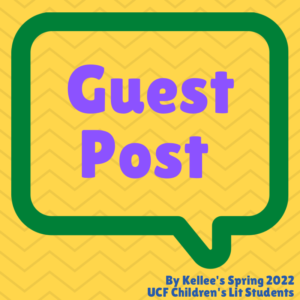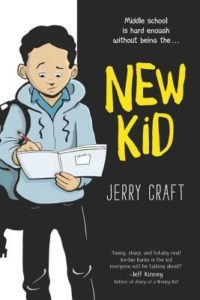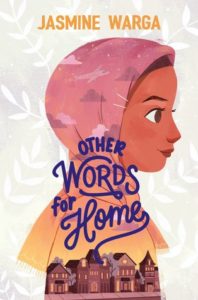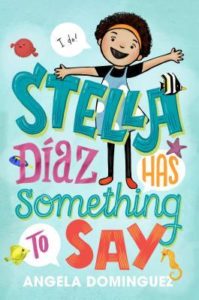One of the assignments during my Spring Children’s Literature course at UCF was creating a mini-teaching guide for the books we read for book clubs. We started with picture books for practice then students created them in their book clubs each week. The course was structured by genre as were the book clubs.
Today, I am happy to share the classroom uses and discussion questions found by my UCF Elementary Education students about these realistic fiction books.
New Kid
Author: Jerry Craft
Published February 5th, 2019 by Quill Tree Books
Summary: A graphic novel about starting over at a new school where diversity is low and the struggle to fit in is real.
Seventh grader Jordan Banks loves nothing more than drawing cartoons about his life. But instead of sending him to the art school of his dreams, his parents enroll him in a prestigious private school known for its academics, where Jordan is one of the few kids of color in his entire grade.
As he makes the daily trip from his Washington Heights apartment to the upscale Riverdale Academy Day School, Jordan soon finds himself torn between two worlds—and not really fitting into either one. Can Jordan learn to navigate his new school culture while keeping his neighborhood friends and staying true to himself?
Teachers’ Tools for Navigation: You can cover social topics like: Inclusion for BIPOC students and new kids, microaggressions, and stereotyping. If you have a new student in the class, maybe they could read and relate to this book. How to like the way Liam treated Jordan. Maybe you could also use Andy as an example of how not to treat others, since he is the antagonist of the story. Jordan also learned throughout the book how to be more confident, outspoken, stand up for others (telling the teacher that Andy was in the wrong over Drew in the lunch room scene), and how to be a bigger person (Jordan signing Andy’s yearbook at the end of the year).
Some topics for navigation would be using this text to discuss family dynamics and friendships. It would be great to also bring up the topic of diversity, bullying, and respect in the classrooms. Most of the characters in the book have some kind of conflict going on. Draw these conflicts to the students as some of these conflicts may mirror conflicts they could be personally dealing with. Open up the discussion for them to make connections to the story and its characters. Have the students discuss in what ways the conflicts in the book are fueled by social, racial, economic, and cultural differences? Using the book, have students do some freewriting about how to navigate through their emotions, just as Jordan found a way to cope. Teachers can also use the book to have students explore the ways the neighborhood Jordan speaks about is portrayed in the illustrations and words. They can investigate Washington Heights where Jordan and his family live and discuss how or why Jordan would camouflage.
Interdisciplinary options:
- Geography: have students work with maps and have them draw a way that Jordan would have gone to school every day on the bus.
- History: teach about how diversity is viewed now vs what it was in the past and why it is important to have it within our school and classroom.
- Art: Jordan has great drawing skills and he loves to draw about what is going on in his life, maybe the students could try to draw what there day/week has looked like.
Discussion Questions:
- Which of the many pressures that Jordan faced can you relate to the most?
- How do you handle having a new kid at your school?
- How does Jordan handle the impacts of race on his friendships?
- Which character in the book do you identify with the most? Why?
- Why do you think Jordan saying something when the altercation between Drew and Andy happened, made others step up to report the truth, too?
- Jordan states that when he has to ride the bus to school he has to be like a chameleon. In your own words, explain what this simile means.
- In your own opinion, explain why you think the teacher keeps calling Jordan by the wrong name.
- If you were a character in this book, who would you be and why?
- Why do you think Jordan at the end of the book decided to write in Andy’s yearbook?
- Have you ever lost touch with a friend after moving? Why do you think that happens?
- Have you ever been the new kid? What was that like?
- How would you have handled the situation like Jordan where the teacher had his notebook? And why?
- Do you think that Jordan Moving helped develop his character in the book? Why?
- Why do you think Drew reacted upset towards his teacher calling him Deandre?
- Write about a time that you didn’t fit in. What happened? How did this make you feel? Did anyone notice and include you?
- How do you handle having a new kid at your school? Classroom?
Recommended For:
Other Words for Home
Author: Jasmine Warga
Published May 7th, 2019 by Balzer + Bray
Summary: I am learning how to be
sad
and happy
at the same time.
Jude never thought she’d be leaving her beloved older brother and father behind, all the way across the ocean in Syria. But when things in her hometown start becoming volatile, Jude and her mother are sent to live in Cincinnati with relatives.
At first, everything in America seems too fast and too loud. The American movies that Jude has always loved haven’t quite prepared her for starting school in the US—and her new label of “Middle Eastern,” an identity she’s never known before. But this life also brings unexpected surprises—there are new friends, a whole new family, and a school musical that Jude might just try out for. Maybe America, too, is a place where Jude can be seen as she really is.
Teachers’ Tools for Navigation: This book does a great job of taking a situation that is happening in the world and putting it into context in a way that resonates with students as is easy to understand.
A great activity for this book would be “Webbing what’s on my mind.” Students would take moments to write down key concepts throughout the book and talk about how they feel about the themes and issues that they read about. This will also give students time to research issues in the book, research it and then reflect. This will allow students to easily see key concepts in the books and compare their thoughts to the thoughts of their peers. This will allow a group discussion on key elements throughout the story.
Interdisciplinary opportunities:
Social Studies- Students will take this book as an opportunity to research about different countries and cultures to learn more about the characters and what they have gone through. This will also allow the students to understand the differences between the United States and Syria and the changes that Jude went through in the book.
Outreach/Humanitarian Aid- Students can learn about different organizations within their community and learn how to help those around them. Students can participate in drives to help refugees and those displaced by conflict.
Discussion Questions:
- Put yourself in Judes shoes. How would you have felt if you had to move across the country and leave your loved ones behind?
- How does Baba feel when Mama and Jude say goodbye? Provide some examples from the book.
- Why does Issa believe that he should protest?
- Whose side do you understand more, the brothers or the parents?
- Why did Jude have to move away?
- How did Jude’s relationships with the other ELL students affect her confidence in school?
- How did Mama and Jude first describe Cincinnati when they landed?
- How did people treat Layla and Jude differently as one was born in America and spoke fluent English while the other struggled communicating and was seen as more of an outsider?
- How did the behavior of those around Jude change after she began wearing a hijab. What evidence supports this?
- The first time Jude is reminded of home in the US iis when she enters Layla’s family restaurant. How does this affect her relationship with Layla and her comfort level within Layla’s restaurant.
Recommended For:
Stella Díaz Has Something to Say
Author: Angela Dominguez
Published January 16th, 2018 by Roaring Brook Press
Summary: In her first middle-grade novel, award-winning picture book author and illustrator Angela Dominguez tells a heartwarming story based on her own experiences growing up Mexican-American.
Stella Díaz loves marine animals, especially her betta fish, Pancho. But Stella Díaz is not a betta fish. Betta fish like to be alone, while Stella loves spending time with her mom and brother and her best friend Jenny. Trouble is, Jenny is in another class this year, and Stella feels very lonely.
When a new boy arrives in Stella’s class, she really wants to be his friend, but sometimes Stella accidentally speaks Spanish instead of English and pronounces words wrong, which makes her turn roja. Plus, she has to speak in front of her whole class for a big presentation at school! But she better get over her fears soon, because Stella Díaz has something to say!
Stella Díaz Has Something to Say introduces an infectiously charming new character with relatable writing and adorable black-and-white art throughout. Simple Spanish vocabulary is also integrated within the text, providing a bilingual element.
Teachers’ Tools for Navigation: This book would be useful by helping students know that they can overcome the fear of speaking and sharing opinions, beliefs or ideas to other people, even if it means that those opinions may be different from other people. It also has bilingual opportunities!
Discussion Questions:
- Have you ever been the new students at school, if you have, how did you begin to make friends? If you haven’t, did you still feel nervous on your first day, why or why not?
- If you moved to a different state and had to introduce yourself to the class, what would you say? Would you bring gifts for your classmates?
- Do you think it’s an important best friend rule to match one another and no one else or do you think Stella was being over-protective of her best friend?
- List some questions you would ask a new classmate to get to know them. What would you share with a classmate for them to get to know you?
- How does Jenny suggest Stella start conversations with people? Do you think it is good advice?
- Why do you think Stella doesn’t let people see her artwork until it’s perfect?
- Why do you think Stella was afraid of speaking in public?
- How did the spelling bee or marine report help Stella overcome her fear of speaking in public? What has helped you overcome the fear of speaking in public?
- Stella and her family celebrate the new year with a trip to Wisconsin, how does your family celebrate special occasions or holidays?
Recommended For:
From the Desk of Zoe Washington
Author: Janae Marks
Published January 14th, 2020 by Katherine Tegen Books
Summary: Zoe Washington isn’t sure what to write. What does a girl say to the father she’s never met, hadn’t heard from until his letter arrived on her twelfth birthday, and who’s been in prison for a terrible crime?
A crime he says he never committed.
Could Marcus really be innocent? Zoe is determined to uncover the truth. Even if it means hiding his letters and her investigation from the rest of her family. Everyone else thinks Zoe’s worrying about doing a good job at her bakery internship and proving to her parents that she’s worthy of auditioning for Food Network’s Kids Bake Challenge.
But with bakery confections on one part of her mind, and Marcus’s conviction weighing heavily on the other, this is one recipe Zoe doesn’t know how to balance. The only thing she knows to be true: Everyone lies.
Teachers’ Tools for Navigation: This book is AMAZING, and is recommended for all to young readers to dive in. This story is also relatable and a lot of young readers can relate to this story and have a special bond with this book. This story also teaches the lesson to fight for what you believe in which is a great lesson to teach students.
This book would be useful to teach kids to fight for what they believe in. Even though Zoe didn’t know her father, she still fought to prove his innocence and was willing to uncover hard truths.
A great tool to use for this story is chronological order journals and open discussions. This book talks about a tough topic that may be hard for other students and this would be the perfect opportunity for teachers to connect with students and have an honest discussion about how the book makes them feel, what they think, and if they are open to sharing stories. You can also have a “mailbox” where students can send you mail and let them know that whatever mail they send is only for your eyes, if they are uncomfortable with the conversation.
Discussion Questions:
- What is the theme of the book from the desk of Zoe Washington?
- Describe where “From The Desk of Zoe Washington” take place.
- How did the letter’s in the novel make you feel while reading the book?
- What would you have done in Zoe’s mother’s shoes? Why? What about other characters?
- How do you think Zoe’s grandmother handles the situation?
- Why do you think Zoe was so eager to rebuild her friendship with Trevor after he found out about Marcus?
- Describe your favorite scene in the book and the way you imagined it while reading.
- Why do you think it was so important for Zoe to build a relationship with his biological father?
- Describe the conflicts that came up in Zoe and her mothers relationship when Zoe found the letter on her 12th birthday.
Recommended For:









